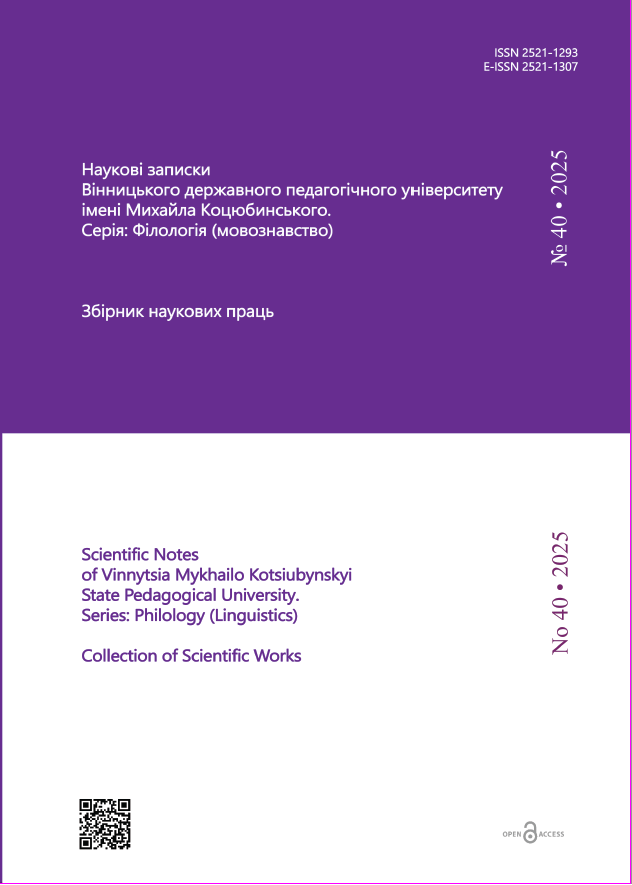Translation of environmental advertising: challenges and nuances
https://doi.org/10.31652/2521-1307-2025-40-17Published 2025-07-07
Keywords
- translation, environmental advertising, literal translation, transcreation, adaptation, multimodality

This work is licensed under a Creative Commons Attribution 4.0 International License.
How to Cite
Abstract
The language of advertising represents a unique type of media discourse, characterized by its multimodal nature. Environmental advertising, in particular, merges linguistic and visual semiotic resources to create coherent and persuasive messages aimed at influencing public awareness and ecological behavior. The increasing global attention to environmental issues has led to a growing need for the effective cross-cultural communication of ecological values, often mediated through translated advertising texts. However, translating environmental advertisements poses numerous challenges due to the interaction of verbal and visual modes, cultural references, and persuasive intentions. This study aims to explore the structural, functional, and semiotic features of environmental advertising texts and to analyze the main difficulties and strategies involved in their translation. Special attention is given to the multimodal characteristics of environmental posters and advertisements and how these impact the process of rendering meaning in the target language. Methods. The research is based on qualitative content analysis of a selected corpus of authentic environmental advertising materials in English. The analysis focuses on identifying the translation techniques used to preserve both form and persuasive function, the functions of these advertisements, the interplay of verbal and non-verbal elements. The study employs a functionalist approach in translation studies, combined with elements of multimodal discourse analysis. Results. The analysis revealed that environmental advertisements fulfill multiple communicative functions, such as informative, persuasive, emotional, aesthetic, educational, and motivating. Structurally, they combine verbal elements with typographic and visual components such as font size, color, layout, visual metaphors, and symbolic imagery. These elements are often used strategically to enhance the argumentation and overall impact of the message. Translators must consider both linguistic content and visual context, as well as the cultural expectations of the target audience. The study identified a range of effective translation strategies, including literal translation, adaptation, and creative translation, with the choice of strategy depending on the dominant function of the original text. Originality. This research contributes to the relatively underexplored area of translating multimodal environmental advertising. It offers a systematic overview of the functional diversity and visual complexity of such texts and emphasizes the importance of interdisciplinary approaches that combine linguistics, translation studies, and semiotics. The findings provide practical insights for translators working in the field of eco-communication and media localization. Conclusion. Translating environmental advertisements requires more than linguistic competence; it demands an understanding of multimodality, cultural semiotics, and persuasive communication strategies. The study concludes that successful translation in this domain is based on a flexible, function-oriented approach that integrates both textual and visual dimensions. Future research may focus on audience reception studies, the role of digital media formats, and the comparative analysis of translation practices across different cultural and linguistic contexts.
Downloads
References
- Добровольська, Д. М., Добровольська, Л. В. (2021). Англомовні комерційні та соціальні слогани у площині перекладу. Науковий вісник Міжнародного гуманітарного університету. Серія: Філологія, вип. 47(3), с. 110-114. https://doi.org/10.32841/2409-1154.2021.47-3.25 DOI: https://doi.org/10.32841/2409-1154.2021.47-3.25
- Мащенко, Т. О., Гнєдкова, О. Г. (2024). Особливості перекладу рекламних слоганів із грою слів і метафорами. Вчені записки ТНУ імені В. І. Вернадського. Серія: Філологія. Журналістика, вип. 6 (35(74)), с. 115-120. https://doi.org/10.32782/2710-4656/2024.6/19 DOI: https://doi.org/10.32782/2710-4656/2024.6/19
- Яблочнікова, В. О. (2021). Стилістичні особливості рекламних текстів та їх відтворення у перекладі. Академічні студії. Серія «Гуманітарні науки», вип. 3, с. 174-178. https://doi.org/10.52726/as.humanities/2021.3.25 DOI: https://doi.org/10.52726/as.humanities/2021.3.25
- Rodríguez-Arcos, I. (2024). Advertising translation in social media: Multimodality and simultaneity in a global campaign. Babel, vol. 70(1–2), pp. 111–137. https://doi.org/10.1075/babel.00373 DOI: https://doi.org/10.1075/babel.00373.rod
- Wang, J., Li, M. (2024). Brand transcreation as multimodal configuration: The (re)making of text, context, and meaning in brand semiotics. Babel, vol. 70(1–2), pp. 89–110. https://doi.org/10.1075/babel.00370. DOI: https://doi.org/10.1075/babel.00370.wan





